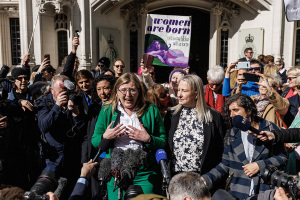Study Sizes Up Gaps Between Christians, Atheists and Agnostics
A new study on America's atheists and agnostics compared the no-faith audience to those who actively participate in the Christian faith.
As more books asserting the absence of God are being published and listed as bestsellers, the Barna Group study found a significant gap between the atheist and agnostic group and the believers as well as some commonalities.
Those who openly identified themselves as an atheist, an agnostic or said they have "no faith" make up only 9 percent of the American adult population. Although only about 1 out of every 11 Americans, the no-faith group numbers roughly 20 million people in a nation of more than 220 million adults, the study noted.
Only about 5 million adults unequivocally use the label "atheist" and staunchly reject the existence of God. The rest have doubts of God's existence but do not outright reject a supreme being.
Most atheists and agnostics (56 percent) agree with the idea that radical Christianity is just as threatening in America as is radical Islam. Two-thirds of active-faith Americans (63 percent) perceive that the nation is becoming more hostile and negative toward Christianity.
Atheists and agnostics were found to be largely more disengaged in many areas of life than believers. They are less likely to be registered to vote (78 percent) than active-faith Americans (89 percent); to volunteer to help a non-church-related non-profit (20 percent vs. 30 percent); to describe themselves as "active in the community" (41 percent vs. 68 percent); and to personally help or serve a homeless or poor person (41 percent vs. 61 percent).
Additionally, when the no-faith group does donate to charitable causes, their donation amount pales in comparison to those active in faith. In 2006, atheists and agnostics donated just $200 while believers contributed $1,500. The amount is still two times higher among believers when subtracting church-based giving.
The no-faith group is also more likely to be focused on living a comfortable, balanced lifestyle (12 percent) while only 4 percent of Christians say the same. And no-faith adults are also more focused on acquiring wealth (10 percent) than believers (2 percent). One-quarter of Christians identified their faith as the primary focus of their life.
Still, one-quarter of atheists and agnostics said "deeply spiritual" accurately describes them and three-quarters of them said they are clear about the meaning and purpose of their life.
When it came to being "at peace," however, researchers saw a significant gap with 67 percent of no-faith adults saying they felt "at peace" compared to 90 percent of believers. Atheists and agnostics are also less likely to say they are convinced they are right about things in life (38 percent vs. 55 percent) and more likely to feel stressed out (37 percent vs. 26 percent).
"Neither the 20 million no-faith adults nor the 58 million active-faith Christians are as internally consistent as those who write and speak on behalf of their groups make them out to be," said David Kinnaman, president of The Barna Group. "Proponents of secularism suggest that rejecting faith is a simple and intelligent response to what we know today. Yet, most of the Americans who overtly reject faith harbor doubts about whether they are correct in doing so. Many of the most ardent critics of Christianity claim that compassion and generosity do not hinge on faith; yet those who divorce themselves from spiritual commitment are significantly less likely to help others."
The two groups also have some commonalities. Both said they are in serious debt with 11 percent no-faith adults and 10 percent of active-faith adults admitting it. Also, 13 percent of no-faith Americans and 12 percent of believers are dealing with a personal addiction; and both groups are also trying to find a few good friends (41 percent vs. 40 percent). Both groups are also equally likely to say they have discussed political, moral and spiritual issues with others in the last month. And about one-fifth of both groups said they often try to persuade other people to change their views.
On another note, Christians are more likely to admit to being overweight with 41 percent admitting it compared to 26 percent of no-faith adults.
"Ironically ... both atheists and committed Christians share one unusual area of common ground: concern about superficial, inert forms of Christianity in America," Kinnaman stated. "There are nearly 130 million American adults who describe themselves as Christians, but who are Christian in name only; their behavior includes little related to experiencing and expressing their alleged faith in Christ."
The study further found atheists and agnostics to be younger, more likely to be male and unmarried, earn more and more likely to be college graduates.
According to study results, 81 percent of the no-faith group say they adapt easily to change compared to 66 percent of active-faith Americans.
Only 6 percent of those aged 61 and older and 9 percent of 42-60-year-olds identify themselves in the no-faith group. Among younger generations, 14 percent of 23-41-year-olds say they are atheist or agnostic and 19 percent of those aged 18-22 identify themselves with that group.
"It is important for Christians to understand the environment and the perspectives of people who are different from them, especially among young generations whose culture is moving rapidly away from Christianity," said Kinnaman. "Believers have the options of ignoring, rejecting or dealing with the aggressiveness of atheists and those hostile to the Christian faith. By their own admission, Christians have difficulty handling change, admitting when they are uncertain of something, and responding effectively to divergent perspectives. These characteristics make the new challenges facing Christianity even more daunting."
The Barna study is based upon a series of nationwide telephone surveys conducted from January 2005 through January 2007 on 1,055 adults who identified themselves as atheists or agnostics and 3,011 active-faith adults aged 18 and older. Each study included at least 250 active-faith adults and 100 atheists and agnostics.





























